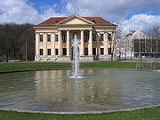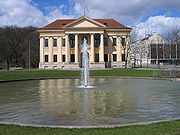
Karl von Fischer
Encyclopedia
Karl [Carl] von Fischer was a German architect
. His drafts had enormous influence on the architecture of classicism
in South Germany.
 Fischer was born in Mannheim
Fischer was born in Mannheim
. From 1796 Fischer was trained by Maximilian von Verschaffelt before he moved to Vienna
in 1799 to study architecture under Ferdinand von Hohenberg. His first work designed in the age of only 22, the Prinz-Carl-Palais
in Munich
, made him famous abruptly and he became a professor for architecture at the Academy of Fine Arts, Munich
in 1808. From 1811 onwards Fischer constructed the National Theatre
. He also created the draft for the extension of Munich, especially for the Brienner Strasse with the Karolinenplatz and the Königsplatz
. Fischer, who was a representant of pure classicism
and rejected romantic historism, was soon displaced by Leo von Klenze
as chief architect for the Bavarian court. He died in Munich and is buried in the Alter Südfriedhof
.
Architect
An architect is a person trained in the planning, design and oversight of the construction of buildings. To practice architecture means to offer or render services in connection with the design and construction of a building, or group of buildings and the space within the site surrounding the...
. His drafts had enormous influence on the architecture of classicism
Classicism
Classicism, in the arts, refers generally to a high regard for classical antiquity, as setting standards for taste which the classicists seek to emulate. The art of classicism typically seeks to be formal and restrained: of the Discobolus Sir Kenneth Clark observed, "if we object to his restraint...
in South Germany.

Mannheim
Mannheim is a city in southwestern Germany. With about 315,000 inhabitants, Mannheim is the second-largest city in the Bundesland of Baden-Württemberg, following the capital city of Stuttgart....
. From 1796 Fischer was trained by Maximilian von Verschaffelt before he moved to Vienna
Vienna
Vienna is the capital and largest city of the Republic of Austria and one of the nine states of Austria. Vienna is Austria's primary city, with a population of about 1.723 million , and is by far the largest city in Austria, as well as its cultural, economic, and political centre...
in 1799 to study architecture under Ferdinand von Hohenberg. His first work designed in the age of only 22, the Prinz-Carl-Palais
Prinz-Carl-Palais
The Prinz Carl Palais in Munich is a mansion built in the style of early Neoclassicism in 1804-1806. It was also known as the Palais Salabert and the Palais Royal, after its former owners....
in Munich
Munich
Munich The city's motto is "" . Before 2006, it was "Weltstadt mit Herz" . Its native name, , is derived from the Old High German Munichen, meaning "by the monks' place". The city's name derives from the monks of the Benedictine order who founded the city; hence the monk depicted on the city's coat...
, made him famous abruptly and he became a professor for architecture at the Academy of Fine Arts, Munich
Academy of Fine Arts, Munich
The Academy of Fine Arts, Munich was founded 1808 by Maximilian I Joseph of Bavaria in Munich as the "Royal Academy of Fine Arts" and is one of the oldest and most significant art academies in Germany...
in 1808. From 1811 onwards Fischer constructed the National Theatre
National Theatre (Munich)
The National Theatre Munich is an opera house in Max-Joseph-Platz, in Munich, Germany. It is the home of the Bavarian State Opera, and the Bavarian State Ballet ....
. He also created the draft for the extension of Munich, especially for the Brienner Strasse with the Karolinenplatz and the Königsplatz
Königsplatz
Königsplatz is a square in Munich, Germany.-Architecture:The square was designed with the creation of the Brienner Straße at the command of Crown Prince Ludwig of Bavaria by Karl von Fischer and laid out by Leo von Klenze....
. Fischer, who was a representant of pure classicism
Neoclassical architecture
Neoclassical architecture was an architectural style produced by the neoclassical movement that began in the mid-18th century, manifested both in its details as a reaction against the Rococo style of naturalistic ornament, and in its architectural formulas as an outgrowth of some classicizing...
and rejected romantic historism, was soon displaced by Leo von Klenze
Leo von Klenze
Leo von Klenze was a German neoclassicist architect, painter and writer...
as chief architect for the Bavarian court. He died in Munich and is buried in the Alter Südfriedhof
Alter Südfriedhof
The Alter Südfriedhof is a cemetery in Munich, Germany. It was founded by Duke Albrecht V as a plague cemetery in 1563 about half a kilometer south of the Sendlinger Gate between Thalkirchner and Pestalozzistraße.-History:...
.
See also
- Neoclassical architectureNeoclassical architectureNeoclassical architecture was an architectural style produced by the neoclassical movement that began in the mid-18th century, manifested both in its details as a reaction against the Rococo style of naturalistic ornament, and in its architectural formulas as an outgrowth of some classicizing...
- Greek revival

